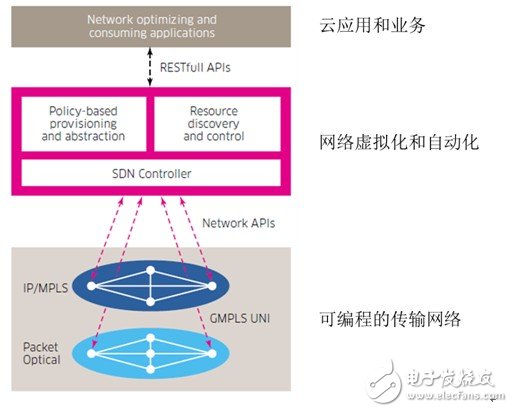Foreword
Allowing applications to use IT computing and storage capabilities on demand, Cloud CompuTIng technology has revolutionized the way people design and operate data centers (IDCs). SDN technology introduces this on-demand concept into the network: allowing applications to consume network transmission resources as much as using virtual computing and storage capabilities. In SDN-based data center networks, network connections are no longer permanent, they are fired by virtual machines (VCs); they no longer exist after virtual machines are disassembled. When cloud computing technology extends across metropolitan and wide-area networks to multiple data centers, new applications based on distributed cloud architectures also expect operators to upgrade their networks using SDN technology, allowing them to consume network transmission resources on demand.

Figure 1 Impact of cloud architecture and cloud services on transport networks
Applying SDN technology to metropolitan area networks and wide area networks is not an easy task. Unlike a simple network topology in a data center, a single vendor architecture, and the ability to think of having unlimited bandwidth resources, the topology of an operator's network is often more complex, with more diverse vendors, such as bandwidth and technology. . Any attempt to accelerate and automate metro and WAN transport services must be consistent with existing service deployment systems. The dynamic consumption model of distributed cloud services will inevitably exert tremendous pressure on existing network operation modes based on static and predictable traffic. Operators need to adjust the existing traffic engineering sequence through dynamic resource management to ensure that the transmission network can improve network efficiency, provide service protection and high applicability in the face of extremely fast changing cloud service connection requirements.
The entire communication industry has begun the pace of evolution to SDN. The corresponding technical proposals include network abstraction and the opening of private data and transport layer capabilities to external control through the OpenFlow protocol. Although this is a good starting point, operators need a more extended SDN architecture to achieve greater value. This architecture needs to be able to span multiple layers (including optical, electrical, Ethernet, IP, and IP VPN service layers). Deploy and implement the interrelationship of topology, transport resources, and physical constraints. Only a multi-layer SDN architecture has a full network view and unified control capabilities, achieving a beautiful vision of SDN: increasing the flexibility, scalability and efficiency of the metropolitan area network and the wide area network.
Reasons for deploying SDN in metro and WAN
Traditional metro and wide area networks are designed for relatively static and predictable network services: connecting remote enterprise branches and corporate headquarters at the center responsible for business processes. The deployment of network services is generally implemented through complex IT/OSS systems using low-level APIs from different vendors and manually configured via command line interfaces or script files. Operators are willing to spend days or even weeks doing this because they believe that these network services will exist for a long time. Now, the emergence of distributed cloud architecture will have a huge impact on this network operation model.
For example, once the basic transmission network infrastructure is put into use, enterprise users require that the transmission services of the metropolitan area network and the network area network be dynamically established and deleted in a few seconds like the data center. They require operators to ensure fast, on-demand delivery services that meet latency, jitter and bandwidth requirements. As another example, when a virtual machine (VM) dynamically moves according to the availability of virtual computing and storage capabilities, enterprise users require operators to provide different network connectivity services for daytime network traffic processing and nighttime data backup. At this time, operators can consider providing bandwidth or reserved bandwidth on demand.
Operators need a fast and cost-effective way to provide advanced network services to enterprise customers. To do this, they need to abandon this time-consuming manual business deployment model and need to quickly increase the competitiveness of their businesses by providing new network services. . To meet these requirements, operators need standardized high-level APIs to abstract the network.
When the network traffic model begins to become more dynamic, operators begin to face the complexity of the network operations introduced thereby, and the network planning cycle that has been going on for several months will no longer apply to guarantee the quality of the service. In order to ensure that network services will not use up bandwidth or deviate from pre-set QoS, operators need to revisit network resource allocation and traffic engineering decisions more frequently.
When mapping network service requirements to transmission resources, operators need to perform real-time network analysis, so that they can choose to meet the customer's SLA requirements and ensure that the transmission resources are used in the most economical way. To assist with real-time routing and computation, operators need the ability to have real-time full-network views and the ability to deploy transport resources on demand, and these multi-layered full-network views and control capabilities are not available today for a variety of reasons.
Transport network optimized for cloud services
To carry cloud services, operators need a multi-layered SDN architecture to divide the network into two main components: network virtualization automation components and programmable transport networks.

Figure 2 Alcatel-Lucent's transport network SDN architecture optimized for cloud services
Wall Mounted Underwater Light,Lights For Pool,Underwater Led Light,12V Pool Light
SHENGYA LIGHTING TECHNOLOGY CO., LTD. , https://www.syalighting.com